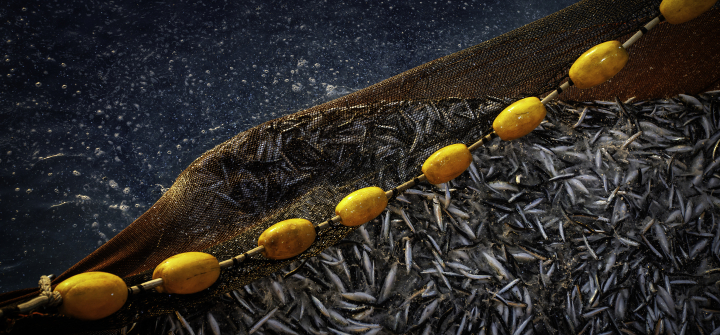How Wild Fisheries Can Reduce Hidden Hunger
There’s an overlooked solution to the hidden hunger afflicting an estimated two billion people worldwide: fish.
If we want to address hidden hunger—malnutrition caused by deficiencies of essential micronutrients like iron and vitamin A—we need to introduce more fish into the diets of the world’s poorest populations.
But to do so, we must confront the many factors that cause the inefficient use and depletion of the Earth’s wild fish stocks.
Fish, especially small species that are consumed whole, are a nutritional powerhouse, full of calcium, iron, zinc, vitamin A, fatty acids, protein, and other essential nutrients.
In many developing countries, wild fisheries are the primary source of local fish and an affordable source of nutrients. For example, marine fisheries in Somalia, Madagascar, and Sierra Leone (countries with extensive coastlines) contribute 20%, 30%, and 41% respectively of the overall nutrient supply of iron, zinc, calcium, omega-3 fatty acids (DHA and EPA), and vitamins A and B12 for coastal populations, according to a 2023 Nature analysis. And fish from Malawi and Zambia’s inland fisheries were the most commonly consumed animal-source food among children under two living in rural areas.
“Many coastal communities, particularly in low-income countries, really depend on fish as a sole source of some micronutrients,” William Cheung, PhD, director of the Institute for the Oceans and Fisheries at the University of British Columbia, told me.
Despite their contribution, wild fisheries are generally overlooked in nutrition strategies. This is particularly alarming because overfishing, pollution, infrastructure development (such as dams), and other environmental threats have led to declines in wild fish stocks, posing significant risks to the nutrient supply for millions of people. About 35% of marine fish stocks are overfished, up from 10% in the 1970s, according to UN FAO estimates. Almost a third of freshwater fish species face extinction, a 2021 study found—a concerning amount since freshwater fisheries are a major source of protein for about 200 million people globally.
Cheung co-authored a seminal 2016 Nature analysis that estimated that 10% of the global population could face micronutrient and fatty acid deficiencies in the coming decades from fish-catch declines. Countries like Ghana, Mozambique, Senegal, Nigeria, and Cameroon were among the most vulnerable due to their high dependence on fish for nutrition.
But if action is taken to improve fisheries management, change how fish harvests are used, and keep fish for local populations, wild fisheries can continue to supply nutrients for the millions of people already dependent on them and be sustainably leveraged to improve the nutritional status of millions more. Consider the following studies:
- Strategically expanding the global conservation network of marine protected areas by just 5% could increase the future fish catch by at least 20%, per a 2020 PNAS study.
- Improving how fish harvests are used can significantly increase the amount of seafood available for people to eat, a 2023 Communications Earth & Environment study found. About 20% of all seafood caught is used to make products like animal feed and fish oil, another 11% is discarded due to undesirable features like small size, and nutritious parts like heads, bones, and skin are often thrown out during fish processing.
- Retaining fish for local populations could help alleviate nutritional deficiencies, per a 2019 Nature study. Researchers estimate that for 22 countries, mostly in Asia and West Africa, just 20% of their marine fish catch could meet the dietary requirements for iron, calcium, and vitamin A for children under five. But in many of these areas, a substantial portion of fish catch (especially the nutritious small species) is exported, depriving local populations of this healthy food.
Given the contributions of fish to nutrition, the global health community cannot afford to overlook wild fisheries as it seeks to combat hidden hunger. Global health organizations that are interested in integrating wild fisheries into strategies to improve nutrition can turn to USAID’s Innovation Lab for Fish for more information.
One example: The USAID-supported Samaki Salama project in coastal Kenya, which has high rates of overfishing and child malnutrition, brought together fisheries and nutrition experts to implement sustainable fishing practices and improve children’s diets.
The project worked with fishers to use more environmentally friendly fishing traps and trained caregivers on how to improve children’s diets. Fishers who used the improved traps caught fewer juvenile fish (which benefits fish stocks), had 10% higher fish catches by weight, took more fish home to their families, and their children ate more balanced diets including fish.
Such efforts make clear that integrating wild fisheries into nutrition programs to tackle hidden hunger can be a win-win for people and the environment.
Anila Jacob, MD, MPH, is a physician and food security and global health specialist who works in international development.
Ed. Note: This is the latest in an occasional series of commentaries by Anila Jacob that uncovers nontraditional opportunities for the global health community to save lives and improve health, including “Barriers to Land Ownership Create Barriers to Health for Millions of Women” and “Five Reasons Why the Global Health Community Should Help Save Forests.”
Join the 50,000+ subscribers in 170+ countries who rely on Global Health NOW summaries and exclusive articles for the latest public health news. Sign up for our free weekday newsletter, and please share with friends and colleagues.
Small fish like these sardines are a nutritional powerhouse full of essential nutrients. Damir Sagolj/Getty Images





